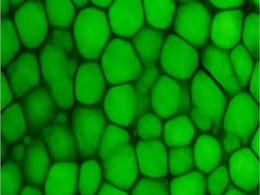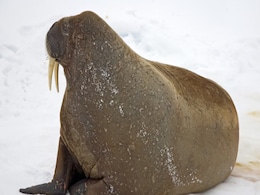Modern Mammals
- All
- News
-

New Cartilage Type Found: Lipocartilage Resembles Fat, Boosts Elasticity
- Saturday January 11, 2025
- Written by Gadgets 360 Staff
Scientists have identified lipocartilage, a newly classified type of cartilage featuring fat-filled, balloon-like cells that offer elasticity and structural stability. Found in the external ears, noses, and throats of mammals, including humans, this tissue differs from traditional cartilage types by maintaining its size regardless of calorie intake...
-
 www.gadgets360.com
www.gadgets360.com
-

Research Shows Twin Births Were Common in Ancient Primate Evolution
- Monday January 6, 2025
- Written by Gadgets 360 Staff
Research suggests that ancient primates, including early humans, typically gave birth to twins, a common trait in their evolutionary history. Over time, singletons became more prevalent due to the survival advantages of larger, more developed offspring. This shift is linked to the evolution of primates' larger brains and bodies, requiring more ener...
-
 www.gadgets360.com
www.gadgets360.com
-

Extinct Walrus-like Mammal Discovered in Atlantics, Provides New Insights into Marine Evolution
- Sunday August 18, 2024
- Gadgets 360 Staff
Recent findings have unveiled Ontocetus posti, an extinct walrus-like mammal that lived 2.2 million years ago. Led by Dr. Mathieu Boisville from the University of Tsukuba, this discovery, made from fossils found in Norwich, UK, and Antwerp, Belgium, provides fresh insights into the evolutionary history of walruses. Initially misidentified, the foss...
-
 www.gadgets360.com
www.gadgets360.com
-

Global Warming Triggered Reptile Boom Millions of Years Ago: Says Study
- Saturday August 20, 2022
- Edited by Gadgets 360 Newsdesk
A new study indicates that global warming, rather than mass extinction was behind a boom in reptile population and diversity. Researchers, from the Department of Organismic and Evolutionary Biology and the Museum of Comparative Zoology at Harvard University, have revealed that the evolution of reptiles began much earlier than previously thought.
-
 www.gadgets360.com
www.gadgets360.com
-

How Mammals Became Good Listeners? New Fossils Reveal
- Friday December 6, 2019
- Science | Agence France-Presse
Modern mammals, including humans, owe their keen sense of hearing to three tiny bones in the middle ear that were absent in their reptile ancestors, but the point at which this transformation occurred has remained unclear.
-
 www.ndtv.com
www.ndtv.com
-

New Cartilage Type Found: Lipocartilage Resembles Fat, Boosts Elasticity
- Saturday January 11, 2025
- Written by Gadgets 360 Staff
Scientists have identified lipocartilage, a newly classified type of cartilage featuring fat-filled, balloon-like cells that offer elasticity and structural stability. Found in the external ears, noses, and throats of mammals, including humans, this tissue differs from traditional cartilage types by maintaining its size regardless of calorie intake...
-
 www.gadgets360.com
www.gadgets360.com
-

Research Shows Twin Births Were Common in Ancient Primate Evolution
- Monday January 6, 2025
- Written by Gadgets 360 Staff
Research suggests that ancient primates, including early humans, typically gave birth to twins, a common trait in their evolutionary history. Over time, singletons became more prevalent due to the survival advantages of larger, more developed offspring. This shift is linked to the evolution of primates' larger brains and bodies, requiring more ener...
-
 www.gadgets360.com
www.gadgets360.com
-

Extinct Walrus-like Mammal Discovered in Atlantics, Provides New Insights into Marine Evolution
- Sunday August 18, 2024
- Gadgets 360 Staff
Recent findings have unveiled Ontocetus posti, an extinct walrus-like mammal that lived 2.2 million years ago. Led by Dr. Mathieu Boisville from the University of Tsukuba, this discovery, made from fossils found in Norwich, UK, and Antwerp, Belgium, provides fresh insights into the evolutionary history of walruses. Initially misidentified, the foss...
-
 www.gadgets360.com
www.gadgets360.com
-

Global Warming Triggered Reptile Boom Millions of Years Ago: Says Study
- Saturday August 20, 2022
- Edited by Gadgets 360 Newsdesk
A new study indicates that global warming, rather than mass extinction was behind a boom in reptile population and diversity. Researchers, from the Department of Organismic and Evolutionary Biology and the Museum of Comparative Zoology at Harvard University, have revealed that the evolution of reptiles began much earlier than previously thought.
-
 www.gadgets360.com
www.gadgets360.com
-

How Mammals Became Good Listeners? New Fossils Reveal
- Friday December 6, 2019
- Science | Agence France-Presse
Modern mammals, including humans, owe their keen sense of hearing to three tiny bones in the middle ear that were absent in their reptile ancestors, but the point at which this transformation occurred has remained unclear.
-
 www.ndtv.com
www.ndtv.com






